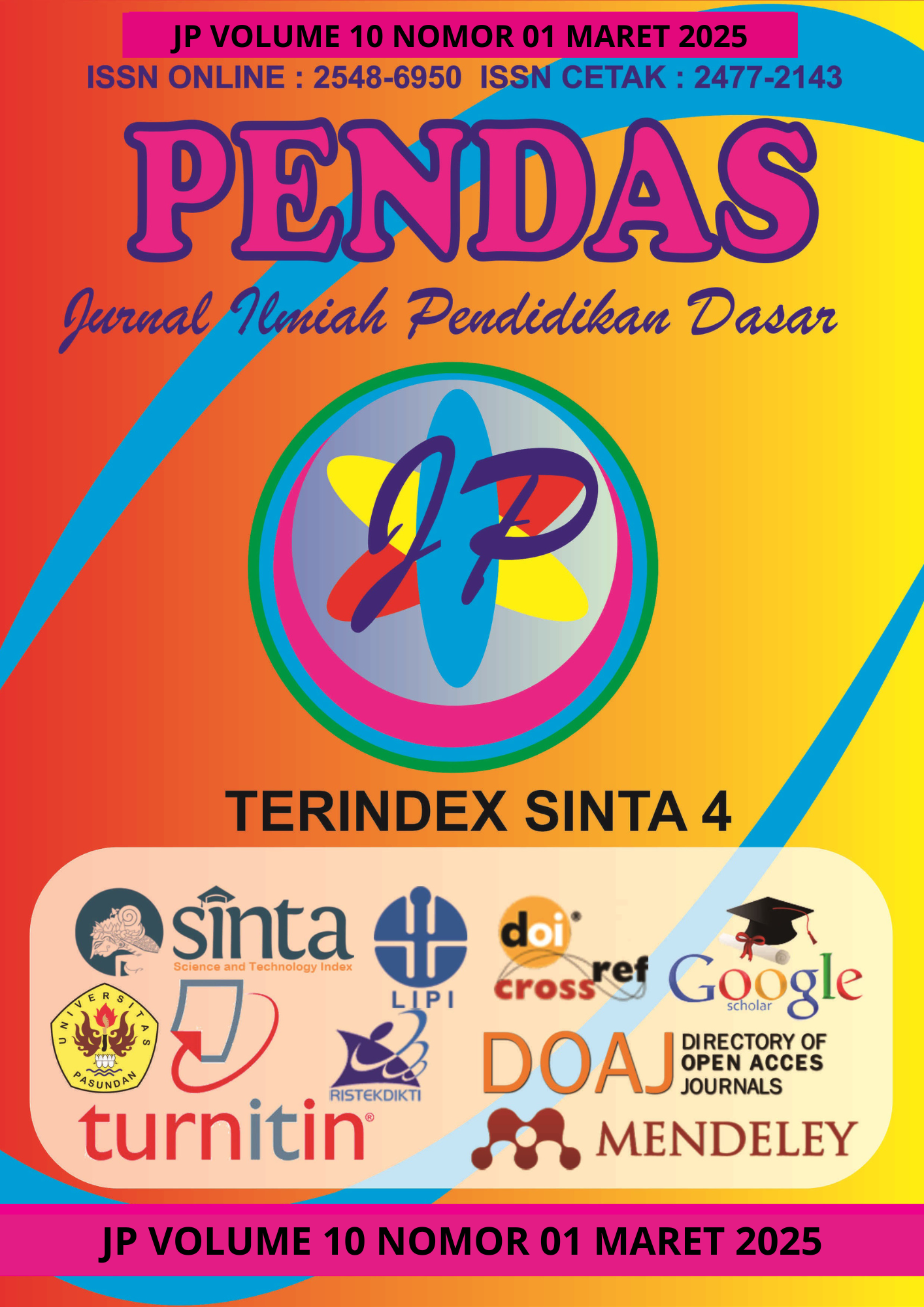PENGARUH PROBLEM BASED LEARNING BERBANTUAN KAHOOT TERHADAP NUMERASI SISWA
DOI:
https://doi.org/10.23969/jp.v10i01.23401Keywords:
Problem Based Learning, Kahoot, NumerasiAbstract
This study found that fifth-grade elementary school students have low numeracy
skills due to the lack of use of models and learning media. To address this issue,
the Problem Based Learning model assisted by Kahoot was used. This study aims
to evaluate the effects of the model on students' numeracy skills and the activity of
using Kahoot. The methodology used is Quasi-Experimental quantitative research
with a Posttest-Only Control Group design. The research population consists of fifth
grade students at Hang Tuah 10 Juanda Elementary School, with a sample of all
students from classes V-A and V-D totaling 42 students, selected using the Cluster
Random Sampling technique. Information was collected through tests and
observations, using test sheets and student activity observation sheets as
instruments. Data processing involves normality tests, homogeneity tests, and
hypothesis tests (T-test). The results of the T-test show that Problem Based
Learning assisted by Kahoot significantly improves students' numeracy skills. In
addition, observations show that students are actively engaged in various learning
activities in the classroom. It is concluded that the use of Kahoot as a learning
medium has a positive impact on the improvement of students' numeracy skills.
Downloads
References
Afsari, S., Safitri, I., Harahap, S. K., &
Munthe, L. S. (2021). Systematic
Literature Review: Efektivitas
Pendekatan
Pendidikan
Matematika
Pembelajaran
Realistik
Pada
Matematika.
Indonesian Journal of Intellectual
Publication,
1(3),
189–197.
https://doi.org/10.51577/ijipublica
tion.v1i3.117
Anderha, R. R., & Maskar, S. (2021).
Pengaruh Kemampuan Numerasi
Dalam Menyelesaikan Masalah
Matematika Terhadap Prestasi
Belajar Mahasiswa Pendidikan
Matematika [The Effect of
Numerical Ability in Solving
Mathematical
Problems
Learning
Mathematics
Achievement
on
of
Education
Students].
Jurnal
Ilmiah
Matematika Realistik (JI-MR),
2(1), 1–10.
Creswell, J. W. (2014). Research
Design: Qualitative, Quantitative,
and Mixed Methods Approaches.
In Research Defign: Qualitative,
Quantitative, and Mixed M ethods
Approaches.
Djonomiarjo Guru SMK Negeri, T., &
Kab Pohuwato, P. (2020).
Pengaruh Model Problem Based
Learning Terhadap Hasil Belajar.
Jurnal Ilmu Pendidikan Nonformal
Aksar,
05,
39–46.
http://ejurnal.pps.ung.ac.id/index.
php/AKSARA/index
Fatimah, C., Wirnawa, K., & Dewi, P.
S.
(2020). Analisis Kesulitan
Belajar Operasi Perkalian Pada
Siswa
Sekolah
Menengah
Pertama (Smp). Jurnal Ilmiah
Matematika Realistik, 1(1), 1–6.
mr.v1i1.250
Fauzi, A., & Setiawan, H. (2020).
Etnomatematika:
Konsep Geometri
Tradisional
pada
Sasak
Kerajinan
dalam
Pembelajaran Matematika di
Sekolah Dasar. Didaktis: Jurnal
Pendidikan
Dan
Ilmu
Pengetahuan, 20(2), 118–128.
https://doi.org/10.30651/didaktis.
v20i2.4690
Inayah, R. (2021). Implementasi
Model Pembelajaran Problem
Based Learning(Pbl) Terhadap
Keaktifan Peserta Didik Dan
Kreativitas Peserta Didik Pada
Mata Pelajaran Matematika Kelas
Viii
Mts Matholi"Ul Huda Pati
Tahun Ajaran 2020/2021. 9–33.
Indraswara, W. T., Kusmaharti, D., &
Yustitia,
V.
Kesalahan
(2023). Analisis
Siswa
dalam
Menyelesaikan Soal Numerasi
Ditinjau dari Self Efficacy. Indo
MathEdu Intellectuals Journal,
4(3),
1685–1708.
https://doi.org/10.54373/imeij.v4i
3.324
Kurniawati,
putri.
(2022).
PENGARUH MODEL FLIPPED
CLASSROOM BERBANTUAN
KAHOOT TERHADAP DAYA
INGAT
DAN
SELF
CONFIDENCE PESERTA DIDIK.
Universitas
Nusantara
Kediri, 01, 1–7.
PGRI
Manasikana, A. (2022). Analisis
Kemampuan
Numerasi
Matematis Siswa Sekolah Dasar
Berdasarkan Kemampuan Awal
Matematika. 1–64.
Marwa, Kresnadi, H., & Pranata, R.
(2023). Pengaruh Model Problem
Based Learning Berbantuan
Media Digital Kahoot Terhadap
Pemahaman Konsep Matematis
Peserta Didik Kelas V SD
Mujahidin Pontianak. Journal on
Education, 06(01), 6760–6769.
N Camelia, E. S. (2023). SEMINAR
NASIONAL
JURUSAN
MATEMATIKA 2023 (Issue
November).
Nanda, V. P. (2024). IMPLEMENTASI
NUMERASI PADA SEKOLAH
PENGGERAK DI SEKOLAH
DASAR. Αγαη, 15(1), 37–48.
Nurjanah, M., Dewi, D. T., Al Fathan,
K. M., & Mawardini, I. D. (2022).
Literasi
Numerasi
Pembelajaran
Dalam
Tematik.
Muallimuna : Jurnal Madrasah
Ibtidaiyah, 7(2), 87.
Pendidikan, J. I., Pembelajaran, D.,
Pendidikan, J., & Sekolah Dasar,
G. (2020). PENGARUH MODEL
PEMBELAJARAN
PROBLEM
BASED LEARNING TERHADAP
KEMAMPUAN BERPIKIR KRITIS
SISWA SD PADA MUATAN IPA
Resti Fitria Ariani.
Rahimah Ikhsani, S., Tangawunisma,
A., Sholeha, A., Divanka, P., &
Setiabudi,
D.
Karakteristik
Tematik
I.
(2023).
Pembelajaran
Yang Ideal Pada
Sekolah Dasar. Student Scientific
Creativity Journal (SSCJ), 1(1),
290–295.
Richter, L. E., Carlos, A., & Beber, D.
M. (2011). Learning to Teach.
Siregar, B., & Veronika, C. (2022).
Pengaruh Model Pembelajaran
Pencapaian Konsep Terhadap
Kemampuan Literasi Numerasi
Siswa pada Materi Sistem
Persamaan Linear Dua Variabel
Kelas VIII SMP Negeri 2 Binjai
Tahun Pelajaran 2021/2022.
Siti
Aminah, Febrinurty Charolyna
Panjaitan, Syahral Zakariyya, & Silvina
Noviyanti.
(2022).
Pembelajaran Di Sekolah Dasar.
Jurnal Pendidikan Dan Konseling,
4(3), 244–246.
Slavin, R. E. (1996). Research on
cooperative
learning
and
achievement: What we know,
what
we need to know.
Contemporary
Psychology,
Educational
21(1),
43–69.
https://doi.org/10.1006/ceps.199
6.0004
Sulsana, R. M., Karma, I. N., &
Nurwahidah, N. (2024). Model
Problem
Based
Learning
Berbantuan Media Digital Kahoot
Untuk
Meningkatkan
Pemahaman Konsep Matematis
Peserta Didik Sekolah Dasar.
Jurnal Educatio FKIP UNMA,
10(2),
491–497.
https://doi.org/10.31949/educatio
.v10i2.8669
SUSWATI, U. (2021). Penerapan
Problem Based Learning (Pbl)
Meningkatkan
Hasil
Kimia.
TEACHING :
Belajar
Jurnal
Inovasi Keguruan Dan Ilmu
Pendidikan,
1(3),
127–136.
https://doi.org/10.51878/teaching
.v1i3.444
Syahrizal, H., & Jailani, M. S. (2023).
Jenis-Jenis
Penelitian Dalam
Penelitian
Kuantitatif
dan
Kualitatif. Jurnal QOSIM : Jurnal
Pendidikan, Sosial & Humaniora,
1(1), 13–23.
Ulandari, S., Dewi, N. K., & Istiningsih,
S. (2022). Pengembangan Alat
Peraga Jari Baru (Jaring-Jaring
Bangun Ruang) Berbasis Inkuiri
pada Mata Pelajaran Matematika
Siswa Kelas VI SDN 02 Pejanggik
Praya Tengah. Jurnal Ilmiah
Profesi Pendidikan, 7(1), 216
222.
https://doi.org/10.29303/jipp.v7i1.
428
Wahyuni,
M.
(2020).
Statistik
Deskriptif Untuk Penelitian Olah
Data Manual dan SPSS versi 25.
In
Angewandte
Chemie
International Edition, 6(11), 951
952. (Issue Mi).
Waruwu, M. (2023). Pendekatan
Penelitian Pendidikan: Metode
Penelitian
Kualitatif,
Metode
Penelitian Kuantitatif dan Metode
Penelitian
Kombinasi (Mixed
Method).
Jurnal
Pendidikan
Tambusai, 7(1), 2896–2910.
Yustitia, V., Siswono, T. Y. E., &
Abadi. (2021). Numeracy of
prospective elementary school
teachers: A case study. Journal of
Physics:
Conference Series,
1918(4).
6596/1918/4/042077
Downloads
Published
Issue
Section
License
Copyright (c) 2025 Pendas : Jurnal Ilmiah Pendidikan Dasar

This work is licensed under a Creative Commons Attribution 4.0 International License.



















